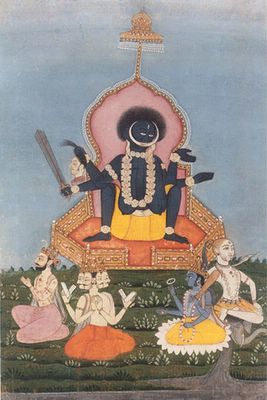
Kali as the Supreme Deity
India (Himachal Pradesh, Chamba?)
Ca. 1800
Pigments on paper
6 7/8 x 10 7/8 in (17.4 x 27.6 cm)
This is a remarkable picture in that it not only unambiguously
demonstrates the supremacy of the goddess Kali but gives an
unusual form of the deity. She is seated on a throne in a
flowering green meadow. In the foreground flows the river
Ganga, which descends from the hair of Shiva, who forms one
leg of the golden throne. Wearing a snake as a necklace, Shiva
sits on an elephant skin. The other three legs of the
throne are formed by the figures of Vishnu with his usual
attributes, the four-headed Brahma, and Indra, with multiple
eyes on his body. Thus there is no doubt about who is in control.
The goddess herself shows some unusual features. She is, of course,
black like Kali but not beautiful. Her large, pendulous breasts, her
distinctive Afro hairdo, the tiny eyes, and the white crescent moon
outlining her face distinguish her from standard forms of Kali. She
also wears a yellow dhoti.
However, like Kali she wears a garland of severed heads and has
four arms with the same attributes, although they are disposed
in the reverse order. The severed head is in the upper right and
the sword in the lower, while the upper left hand exhibits the
gesture of charity and the lower that of assurance. At first sight,
the posture of the goddess seems unusual, but, in fact, it is the
classic position for giving birth and is encountered in early Indian
art in images of other iconographic forms of goddesses both in
India and Nepal. It is also the posture in which Kali sometimes
straddles Shiva, when he is supposed to be a corpse (sava),
the appropriate seat (asana) in heroic (virachara) tantric praxis.
All text and images © The Trustees of the Walters Art Gallery, Baltimore
No comments:
Post a Comment